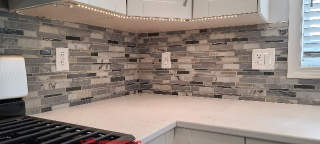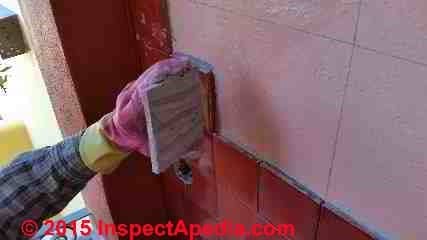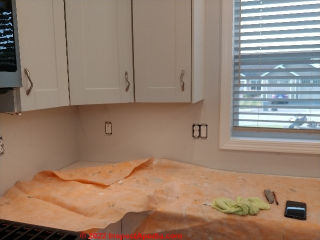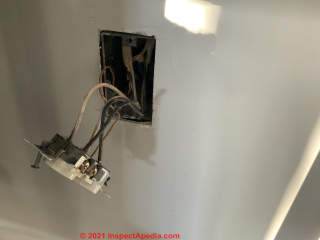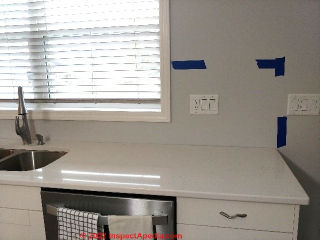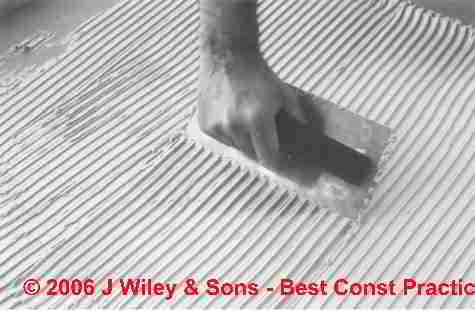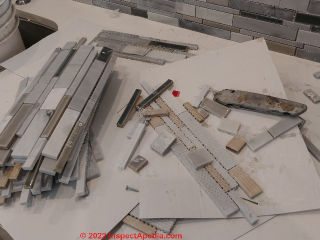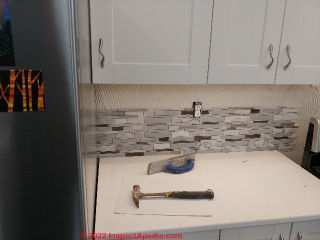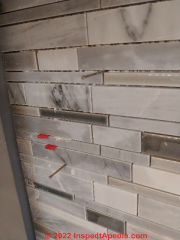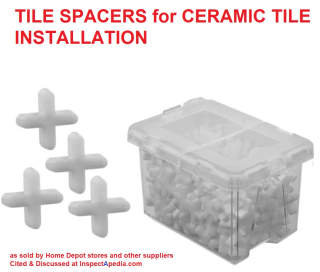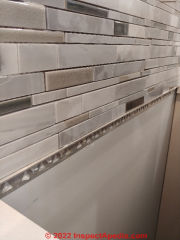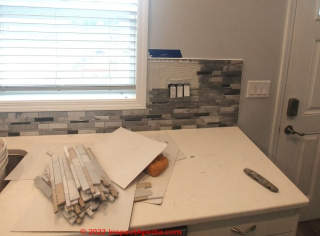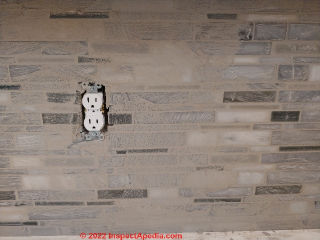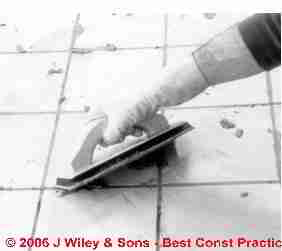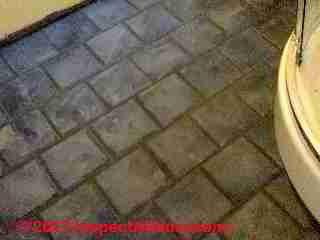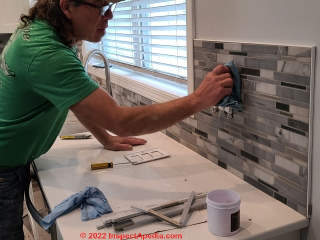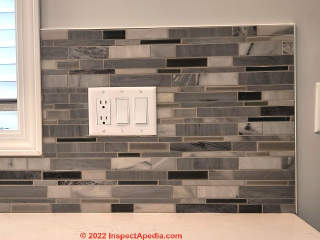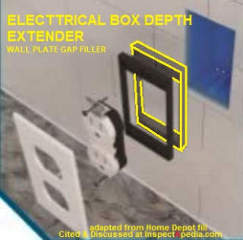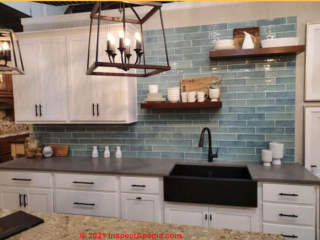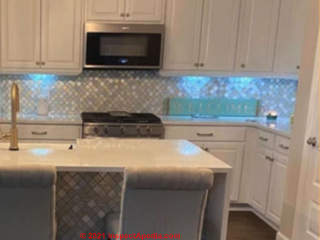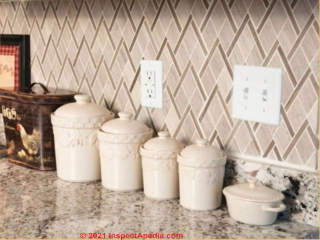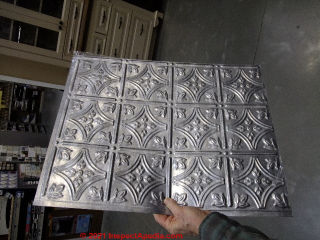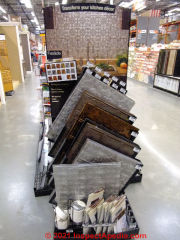 Ceramic Tile Backsplash Choices & Installation
Ceramic Tile Backsplash Choices & Installation
How to select & install a ceramic tile backsplash
- POST a QUESTION or COMMENT about choosing & installing ceramic tile
Ceramic tile backsplash installation above a kitchen or bathroom countertop is explained here.
Page top photo: a blue and white ceramic tile countertop and backsplash installed by the website editor in the 1970s. Note the poor aesthetic design choice of a single white tile stripe that leaves the white receptacle covers intruding into the blue backsplash area. This is not a design suggested by Villalobos, the contributing author found below - Ed.
This article series discusses ceramic floor tile choices & properties, and ceramic tile installation details for kitchens and bathrooms.
InspectAPedia tolerates no conflicts of interest. We have no relationship with advertisers, products, or services discussed at this website.
- Daniel Friedman, Publisher/Editor/Author - See WHO ARE WE?
Ceramic Tile Backsplash Installation Guide
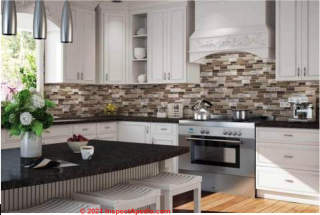 Leonardo Villalobos, Mosaic Tile Outlet, August 2021 + A. Church / D. Friedman, January 2022
Leonardo Villalobos, Mosaic Tile Outlet, August 2021 + A. Church / D. Friedman, January 2022
This article covers the importance of a kitchen backsplash installation, its construction, installation procedure, and and we provide some innovative backsplash ideas utilizing tile patterns, colors, materials, styles that have a significant impact on kitchen design and aesthetic appearance.
[Click to enlarge any image]
Popular Tile Options for a Designer Kitchen Backsplash
Every homeowner loves to make the home aesthetically appealing, well-functioning, and welcoming space for the family and loved ones visiting the home.
The kitchen in every home serves as the ‘energy center’ and it is the most visited part of the home.
A kitchen should have a well-designed backsplash, which can be the focal point in the space. As you know, the walls behind the stove, sink, or oven, sustaining the splashes of oil, water, and more, are known as the kitchen backsplashes.
Though many alternatives are available today, tiling a kitchen backsplash has remained a popular way to beautify the backsplash. Let's discuss some essential aspects of this installation and the trends that are ruling the hearts of most homeowners in recent years.
Why is Kitchen Backsplash Important?
Deciding on the interior decor theme for the kitchen may be confusing, and still, it is very essential.
A kitchen backsplash is not only installed for protecting the wall behind the stove but also as of the most decorative elements in the kitchen. Without a proper backsplash, the wall behind the stove is likely to become greasy and soiled, and you may feel that something is missing in the room.
Because the kitchen backsplashes is a key component in the overall personality of a kitchen, interior designers try matching the tiles with other elements in the space, such as paint on the walls, countertop, furnishing, storage cabinets, other wall decorations, and much more.
The color, pattern or shape, the finish, and the style matter the most to create the aesthetic appeal you desire. Mixing and matching these properties to attain an eye-catching elegance is also fun.
Do you want a modern outlook with glass tiles installed for the tile backsplash?
Or, are you a vintage admirer planning to cover the entire wall with a deco-patterned ceramic tile? Deciding on the interior decor theme for the kitchen may be confusing, and still, it is very essential.
Choose the Best Material for a Tile Backsplash
A tile backsplash should be easy to install, clean, look great, and last for years to come. All these technical aspects rely on the tile material you choose.
Ideally, a backsplash installed with ceramic tiles, porcelain tiles, glass mosaic tiles, marble mosaic tiles, other natural stone tiles like slate, travertine, and metal mosaic tiles would have all the desired properties.
However, many other tile materials can go well.
Below in this article at BACKSPLASH TILE ALTERNTIVES we show a collection of interior backsplash tiles that can help you explore the wide varieties of mosaic tiles used as backsplash material.
Design Features of a Kitchen Backsplash
Photo above: horizontal gray-theme ceramic backsplash tiles installed in a home in Two Harbors, Minnesota. Below we include pictures of the steps in installation of this backsplash.
The homeowners wanted the tile backsplash to extend from countertop surface to the underside of the overhead cabinets, making for both a cleaner design and a wall surface easier to keep clean.
While planning for a new kitchen backsplash installation or a kitchen renovation project, you need to consider the following:
- Backsplash Extent in areas where no wall cabinets are present
- To bottom of windows over the countertop
- To the top of windows over a countertop
- To the ceiling in areas where no cabinets are mounted
- Continuous behind cooktop that might later be replaced or modified. In the photo above you can see that the tile installer took care to continue the ceramic backsplash behind the current stove.
- The area you cover with backsplash tiles should complement the style you are following for your kitchen decor.
- Use the most appropriate grout, adhesive, cement, and tools while installing the tiles. These factors ensure the durability of your installation.
At GROUT INSTALLATION, TILE Steve Bliss notes that the color choice for countertop grout is important as is grout material where stain resistance is a concern.
Tile Color Choices: Harmony or Contrast
Select the backsplash tiles considering creating harmony or contrast with other elements in your kitchen.
How to Install a Ceramic Tile Backsplash
Photo: Website editor [DF] installing a ceramic wall tile in Mexico. Details about this installation are at
WALL, CERAMIC TILE INSTALLATION
Most homeowners hire a professional renovation contractor or a tiling and grouting service provider.
However, if you are confident about your tile installation skills,and if you would enjoy installing your own tile backsplash, you can do so.
The tile material and pattern are the two most essential aspects that derive the installation procedure. The design ideas need a suitable pattern, and the durability of the tiles relies on the materials. However, the way you install the tiles also influences how long they remain on the wall.
10 Easy Steps to Install a Kitchen Backsplash
Below, in the Minnesota home where the tile backsplash will be installed the worker has put down protective covering over the countertop, sink, etc. and has removed the receptacle cover plates.
- Prepare the wall where the backsplash will be installed
Clean the area to be tiled using a sponge and appropriate cleaners, and let it dry thoroughly.
Be sure that there is no oil or grease on the surface to which you'll be gluing up tile.
In preparing the backsplash area you'll need to remove the covers from electrical receptacles so that you can tile around those openings.
Watch out: to avoid a serious, possibly fatal electric shock it's best to turn off electrical power to the receptacles in the backsplash area until the covers are back on those devices.
Watch out: If you leave the electrical receptacles and switches in place and then tile over the electrical switch or receptacle mounting ears, a future electrician or homeowner will curse your stupidity because you've made it very difficult to remove and replace an electrical receptacle or switch when needed later-on.
With electrical power off, we actually remove the electrical receptacles and switches from the wall so that we can reinstall them with their mounting ears on top of the finished tile backsplash surface.
That lets us tile close to the electrical box without worrying that the opening edges won't be covered by the receptacle or switch cover.
Above: an electrical receptacle, with power off, is removed and left hanging out the wall so that we can tile around the receptacle opening. Photo courtesy of InspectApedia reader Kirk.
Photo above: the tile backsplash installer marked with blue tape the intended height and right-side ending terminus for the new backsplash.
The height was chosen to match the height that the tile would reach elsewhere above the countertop where it would encounter the under-side of kitchen cabinets.
- Mark any special tile layout pattern:
Outline the area using a pencil, as per the tile patterns you select.
Measure or use a trial tile layout along the countertop to see how much you need to trim from the starting and finish backsplash tile course tiles at the backsplash right and left ends.
Or for some kitchens, you may elect to show a whole tile at one end of the backsplash and let the odd tile appear only at the other end where it may be less visible.
Keep in mind that you'll also need to cut and trim tiles around the receptacle and switch openings in the backsplash wall.
- Prepare the thin-set tile adhesive mastic and spread it using a notched trowel.
Above, using a notched trowel to spread thin-set tile adhesive / mastic, described in more-detail - image courtesy of Steven Bliss and J. Wiley & Sons, cited in detail
at CERAMIC TILE SETTING COMPOUNDS
Above: long narrow ceramic tiles used in this backsplash installation are sold pre-glued to a plastic mesh that makes tile spacing installation easier and faster. Still some tiles will need to be cut around receptacles, switches, and possibly other locations.
Below: The tile backsplash installer in a Minnesota home begins at the left end of the countertop, placing tile onto adhesive mastic.
Note that the receptacle covers were removed and receptacles pulled out of the way just as in our photo above.
- Install tiles from bottom to top, using spacers [shown above] to maintain a uniform gap between tiles.
Tile spacers are sold in various thicknesses that you'd select to match your tile grout joint width. Typical and as shown here are 1/8" spacers as sold at Home Depot, Menards, Lowes, and other building suppliers.
Watch out: leave space for the flexible joint at backsplash to countertop surface;
Starting at the backsplash area-bottom, install you backer rod OR if you're not using a backer rod, remember to leave space (equal in width to your standard grout joint width) for the flexible sealant between countertop and backsplash bottom edge by trimming legs off off of some of those tile spacers.
In the Minnesota home tile backsplash we noted that the grout joints were rather small; the installer made clever use of a combination of red plastic tile spacers and also simple finishing nails to serve as additional spacers where needed to keep the grout joints uniform.
- Allow the tile adhesive set for a minimum of 24 hours.
|
Then remove the tile spacers and if necessary, clean out the grout joints.
Watch out: before applying grout to the joints, remove any excess tile mastic adhesive that extends close to the surface of the tiles. Otherwise those high points will prevent grout from filling the tile joint properly. Work carefully so as not to disturb or chip the edge of the tiles themselves.
Above: to continue the ceramic tile backsplash behind the stove, where there is no countertop to support the first tile course, the tile installer uses a temporary brace set onto the wall. Once the mastic adhesive has set this horizontal support can be removed.
Above: where the backsplash ends in an open area, the installer includes a suitable edge of marble or similar material.
Above: the tile grout has been applied in a first pass; click to enlarge the image and notice the marks showing the direction of grout sponge movement: generally "across" the grout joints to avoid wiping out too much grout before it has set.
- Prepare & apply the tile grout
Watch out: before grouting the tile backsplash, don't forget to use a flexible sealant for that first horizontal grout joint between the bottom of the tile backsplash and the countertop surface.
When buying tile grout most suppliers can provide a color and texture-matched flexible sealant needed in each tile right-angle joint such as between the countertop surface and the bottom of the backsplash surface or at wall-to-cabinet vertical butt joints.}
If you fill this joint first you won't find yourself later trying to gouge out grout where the sealant needs to be applied.
Watch out: choose a grout of appropriate material and color to minimize future staining on the backsplash
"Using a latex modified grout and sealing the grout will help but will not prevent stains altogether. The best solution is to use an epoxy grout and to choose a dark or neutral grout color such as gray."
- Steven Bliss
Follow the grout manufacturer's instructions, including, as you may read, letting some grout products "rest" for a time before you try to spread the grout into the tile joints.
Spread the into the tile joints using a spatula or spreader to wipe the grout into place.
Ensure you fill all the gaps. Leave the grout a bit high in the joints, as you're going to remove some of it in the next step.
Above, courtesy of Steven Bliss in Best Construction Practices, & J. Wiley & Sons, showing tile grout application using a rubber trowel, cited in detail
at GROUT INSTALLATION, TILE - details of how to apply tile grout.
- Remove excess grout using a damp (not soaking wet) sponge and let the tile grout set - how long?
Typically minutes to an hour or more - follow the manufacturer's instructions.
- Wipe off most of the grout from the tile surfaces once it has set in the grout joints but before it has hardened.
Watch out: Wipe diagonally across the grout joint to avoid removing too much grout from the joints.
Photo above: we have spread the grout into these tile joints (in this case a bathroom floor) and have made a very light first-pass wipe off of excess grout.
Notice the grout haze forming on the tile surfaces?
- Finish wiping off the grout after it has set:
When the grout has set, use a soft damp cloth to wipe off grout haze from the tile surfaces
Watch out: if you wait too long to wipe off the grout haze it can set iron-hard and be very difficult to remove.
- Replace the electrical switch and receptacle covers, using electrical box spaces of an appropriate thickness, and remember to restore power to the receptacle and lighting circuit.
Watch out: After the tile is installed and before you replace the electrical receptacle and switch covers you may need to install gap filler wall plates of an appropriate depth - spacer gaskets - to comply with both safety and the electrical code.
These spacer gaskets bring out the face of the electrical box to flush with the face of the tile backerboard.
For example if the combination of tile mastic and tile thickness brings the face of the wall forward by 3/16" and if the face of the electrical box was originally recessed into the wall by 1/16", you'd buy 1/4" thick electrical box spacers.
More Kitchen Backsplash Design Ideas
Here are some creative backsplash ideas you can consider when you tile backsplash for adding glamour to the space.
Subway Tiles: Timeless Trend
Subway tile is a traditional tile pattern derived from vintage subways. The brick-like construction can be attained by installing tiles with an offset of half of the width from the neighboring tile row. However, many varieties of subway tile help you add a touch of modern elegance to your tile backsplash.
If you are fond of that vintage style statement, the backsplash ideas using subway tile horizontally or vertically or with a wave pattern will help you.
Subway tile is indeed a timeless trend, as it is prevalent even when the technology for manufacturing mosaic tiles is advancing.
Natural Stone Tile Backsplash for an Eye-Catching Aura
Implementing natural stone mosaic tiles, including slate, travertine, marble, or installing peel and stick tiles that look like any natural stone remains a popular way to make your backsplash a focal point in the kitchen.
You can choose appropriate colors and patterns in natural stone mosaics to beautify your backsplash.
Backsplash Ideas for an All-White Kitchen
Implementing white subway tiles or any other tile pattern in white color combines classic and modern style.
Marble is, of course, among the most popular tile materials to add that relaxed, simple, yet beautiful style to your room.
Your ceiling, countertop, storage cabinets, and furnishing can be maintained white or with the texture and appearance of some natural material like wood.
Geometric Tile Patterns to Enhance the Appeal
If you wish to beautify the backsplash wall with some intricate design, with a bold appeal or a contrast with the countertop, you can choose different geometric patterned tiles, like herringbone, chevron, hexagon, and more.
Patterns like puzzles, pebbles, penny rounds, with texture and finish like wood grain, would also look marvelous on the kitchen backsplash.
Hexagon Tile Backsplash
The hexagon tile pattern is perfect for a bold and intricate look with contrast. You can also choose marble hexagon tiles for an all-white room. The grout lines and bold colors, such as metallic gray, black, green, and blue, add exciting appeal to the backsplash for sure.
Herringbone Pattern Kitchen Backsplash Tiles
Herringbone is among the tile shapes used for walls, backsplashes, and even floors.
Feel free to select light or dark colors to go well with the rustic design theme.
Even the neutral color makes your kitchen an interesting and exciting combination of stylish decor elements.
Chevron Pattern Backsplash Tiles
Chevron is another popular tile pattern for the catchy elegance it creates. Though it looks similar to the herringbone pattern, the difference lies in the way tile edges meet.
You can create a fun element and a rustic style by implementing this tile pattern for your next kitchen tile backsplash installation.
Other Kitchen Backsplash Ideas
The wide-ranging tile materials, patterns, styles, finishes, and colors allow you to explore backsplash ideas with novelty and unusual, off-beat kind of combinations.
Watch out: take care to ensure the design idea doesn't look awkward and adds value to your entire space.
Peel-and-Stick or Glue-Up Tile or Panel Backsplash Options
You can instead choose to install "peel-n-stick" for a kitchen backsplash, avoiding having to work with tile adhesive-mastic and in most installations, avoiding grouting the tile joints by butting the peel-and-stick tiles tightly-together. Or you can use a glue-up metal or plastic panel like the one shown above.
Just cut, peel, and stick the tiles ("peel-n-stick") or use construction adhesive (glue-up) to bond the tiles or panels to the wall surface.
This option may appeal when you want to cover an already tiled surface, but keep in mind that you'll have to re-mount and bring forward the electrical receptacle covers already in the wall.
Above we show a third and similar alternative: a glue-up backsplash materials made of metal or of thermoplastic panels (also used on ceilings to simulate antique pressed-tin) that are installed using construction adhesive.
In our OPINION these are an inexpensive, easy-to-apply alternative to a ceramic tile backsplash but one that is nowhere close in quality, durability, nor ease of cleaning.
See these example
- GLUE-UP BACKSPLASH INSTALLATION INSTRUCTIONS [PDF] ACP Panel Classic style decorative thermoplastic panels, from CP POB 1581, Appleton WI 54912 USA, Tel: 800-434-3750.
Contributing authors
InspectAPedia.com provides building and environmental diagnostic and repair information to the public, without cost or fee. In order to absolutely assure our readers that we write and report without bias we do not sell any products nor services, nor do we have any business or financial relationships that could create such conflicts of interest.
- Brian's Tiles, a tile installer in Duluth, Minnesota, installed the ceramic tile backsplash whose photos appear in this article.
Contact Brian's Tiles, LLC 218-343-8843 Email: bags6565@gmail.com Brian's Tiles, LLC can also be found on Facebook and by Google search. - Leonardo Villalobos, Director of Commerce at MOSAIC TILE OUTLET [website] 2301 NW 84th Ave Ste B
Miami, FL 33122 USA, Tel: 1-833-766-7242 Website: https://mosaictileoutlet.com/collections/swimming-pool-tile or https://mosaictileoutlet.com
Mr. Villalobos has been involved in the manufacturing and marketing of mosaic tiles for over 20 years.
...
Continue reading at CERAMIC WALL TILE INSTALLATION or select a topic from the closely-related articles below, or see the complete ARTICLE INDEX.
Or see these
Recommended Articles
- BATH & KITCHEN DESIGN GUIDE - home
- BATHROOM MOLD REMOVAL / PREVENTION
- CEMENT BACKERBOARD INSTALLATION
- CERAMIC TILE BACKSPLASH INSTALLATION
- CERAMIC TILE DAMAGE REPAIR
- CERAMIC TILE FLOOR & WALL
- CERAMIC TILE GROUT INSTALLATION
- CERAMIC TILE SETTING COMPOUNDS
- CERAMIC WALL TILE INSTALLATION
- COUNTERTOPS, KITCHEN & BATH - home
- FLOOR TILE INSTALL on CONCRETE
- FLOOR TILE SEALERS, CERAMIC, STONE
- TILED WALKING SURFACE SLIP HAZARDS
- FLOOR TILE SETTING COMPOUNDS
Suggested citation for this web page
CERAMIC TILE BACKSPLASH INSTALLATION at InspectApedia.com - online encyclopedia of building & environmental inspection, testing, diagnosis, repair, & problem prevention advice.
Or see this
INDEX to RELATED ARTICLES: ARTICLE INDEX to BUILDING INTERIORS
Or use the SEARCH BOX found below to Ask a Question or Search InspectApedia
Ask a Question or Search InspectApedia
Questions & answers or comments about choosing & installing ceramic tile floors in kitchens & bathrooms
Try the search box just below, or if you prefer, post a question or comment in the Comments box below and we will respond promptly.
Search the InspectApedia website
Note: appearance of your Comment below may be delayed: if your comment contains an image, photograph, web link, or text that looks to the software as if it might be a web link, your posting will appear after it has been approved by a moderator. Apologies for the delay.
Only one image can be added per comment but you can post as many comments, and therefore images, as you like.
You will not receive a notification when a response to your question has been posted.
Please bookmark this page to make it easy for you to check back for our response.
IF above you see "Comment Form is loading comments..." then COMMENT BOX - countable.ca / bawkbox.com IS NOT WORKING.
In any case you are welcome to send an email directly to us at InspectApedia.com at editor@inspectApedia.com
We'll reply to you directly. Please help us help you by noting, in your email, the URL of the InspectApedia page where you wanted to comment.
Citations & References
In addition to any citations in the article above, a full list is available on request.
- Best Practices Guide to Residential Construction, by Steven Bliss. John Wiley & Sons, 2006. ISBN-10: 0471648361, ISBN-13: 978-0471648369, Hardcover: 320 pages, available from Amazon.com and also Wiley.com. See our book review of this publication.
- Our recommended books about building & mechanical systems design, inspection, problem diagnosis, and repair, and about indoor environment and IAQ testing, diagnosis, and cleanup are at the InspectAPedia Bookstore. Also see our Book Reviews - InspectAPedia.
- In addition to citations & references found in this article, see the research citations given at the end of the related articles found at our suggested
CONTINUE READING or RECOMMENDED ARTICLES.
- Carson, Dunlop & Associates Ltd., 120 Carlton Street Suite 407, Toronto ON M5A 4K2. Tel: (416) 964-9415 1-800-268-7070 Email: info@carsondunlop.com. Alan Carson is a past president of ASHI, the American Society of Home Inspectors.
Thanks to Alan Carson and Bob Dunlop, for permission for InspectAPedia to use text excerpts from The HOME REFERENCE BOOK - the Encyclopedia of Homes and to use illustrations from The ILLUSTRATED HOME .
Carson Dunlop Associates provides extensive home inspection education and report writing material. In gratitude we provide links to tsome Carson Dunlop Associates products and services.


